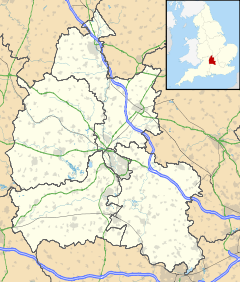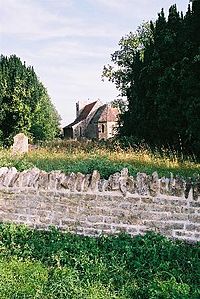- Culham
-
Coordinates: 51°39′07″N 1°15′58″W / 51.652°N 1.266°W
Culham
 Culham shown within Oxfordshire
Culham shown within OxfordshirePopulation 415 (2001 census)[1] OS grid reference SU5095 Parish Culham District South Oxfordshire Shire county Oxfordshire Region South East Country England Sovereign state United Kingdom Post town Abingdon Postcode district OX14 Dialling code 01235 Police Thames Valley Fire Oxfordshire Ambulance South Central EU Parliament South East England UK Parliament Henley Website Culham Village website List of places: UK • England • Oxfordshire Culham is a village and civil parish on the north bank of the River Thames, just over 1 mile (1.6 km) south of Abingdon in Oxfordshire.
Contents
Manor
The toponym comes from the Old English Cula's hamm, referring to the village's position in a bend of the Thames. Culham is known to have existed by the reign of King Coenwulf of Mercia early in the 9th century, by which time the manor belonged to Abingdon Abbey. Soon after the Norman conquest of England part of the manor was seized by William the Conqueror, but the land was restored to the abbey and remained in its possession until the dissolution of the monasteries in 1538.[2]
The west wing of Culham Manor was built in the 15th century as a mediaeval grange for Abingdon Abbey. It is half-timbered, with a stone ground floor and timber-framed first floor. In 1610 it was extended with a new north front and east wing. The east wing was later demolished but the 17th century north front survives.[2]
Parish church
Several records suggest that Culham may have had a chapel since the 9th century. A parish church dedicated to Saint Paul was built in the 12th century. It was cruciform, having a chancel, nave and north and south transepts, and had features from the Early English and Decorated periods. There was a tower, and this was demolished and replaced in 1710. In 1852 the entire church except the 1710 tower was demolished and the Gothic Revival architect Joseph Clarke built a new church in its place in 13th century style.[3] During the rebuilding, heraldic stained glass installed in the north transept in 1638 was transferred to a window in the north aisle of the new church. The tower has a ring of six bells, but currently for technical reasons it is not possible to ring them.[4] St. Paul's is now part of the Bridge Group of churches along with the parishes of Clifton Hampden, Little Wittenham and Long Wittenham.[5]
Culham House is a Georgian house, built by the London builder John Phillips to replace an earlier rectory.
Economic and social history
In 1416-1422 the Abingdon Guild of the Holy Cross built Culham Bridge over the Thames between the village and Abingdon to carry the main road between Abingdon and Dorchester.[2]
During the English Civil War Royalist forces encamped on Culham Hill until June 1643, defending Culham Bridge. In May 1644 the Royalists withdrew from Abingdon and Parliamentarian forces took the bridge, from which they were able to intercept supplies to the Royalist headquarters in Oxford. In January 1645 a Royalist force tried to recapture the bridge and destroy it. The skirmish, known as the Battle of Culham Bridge, ended in a Parliamentarian victory and the Royalist commander Sir Henry Gage was mortally wounded.[2] In 1736 the Parliament passed the first of several Acts to turn the road into a turnpike. It ceased to be a turnpike in the 1870's.[2] In 1922 the Ministry of Transport classified it as the A415 road. In 1928 Oxfordshire County Council built a new bridge for the A415 beside the 15th century one.
Road traffic between Culham and Sutton Courtenay crossed the Thames via Culham Ferry until 1807, when Sutton Bridge was built. In 1809 the Thames Navigation Commissioners built the 0.75 miles (1.21 km) long Culham Cut, a navigation that bypasses a difficult stretch of river past a watermill at Sutton Courtenay. Sutton Bridge was extended to span the cut, and Culham Lock was built on the cut just above the bridge.[2]
In 1795 Culham had at least three public houses: the Nag's Head, the Sow and Pigs (now the Lion) and the Waggon and Horses. In 1846 the Railway Hotel was added next to Culham railway station, and in 1894 a parish boundary change transferred the Nag's Head to Abingdon.[2]
Most of the parish was farmed in an open field system until 1810, when Parliament passed an Inclosure Act for Culham.[2]
In 1844 the Great Western Railway opened an extension from Didcot to Oxford, passing through the eastern part of the parish. The GWR opened a station on the main road and called it Culham, although it is 1.5 miles (2.4 km) east of the village and considerably nearer to Clifton Hampden. Isambard Kingdom Brunel designed the station building, and it has recently been restored by Network Rail. It is served by First Great Western trains.
The village school was built in 1850 and reorganised as an infants' school in 1924. It is now a Church of England primary school.[6]
Culham College
In 1852 Samuel Wilberforce, Bishop of Oxford founded the Diocesan Training College for Schoolmasters (Culham College). The building was extended several times in the 20th century. The college has become Culham Institute,[7] a charitable research organisation associated with the Church of England housed in the Educational Studies Department of Oxford University and in 1978 the European School, Culham was founded in its former buildings.[8]
RNAS Culham
In 1941[2] the Fleet Air Arm opened Royal Naval Air Station, HMS Hornbill, between Culham railway station and Clifton Hampden village. Most of the airfield is in Clifton Hampden parish, but HMS Hornbill was also called RNAS Culham. The Admiralty closed the airfield in 1956[2] and transferred it to the UK Atomic Energy Authority in 1960. The former airfield is now the Culham Science Centre,[9] an 800,000 square metre scientific research site that includes two nuclear fusion experiments: JET and MAST. The START Nuclear Fusion Experiment was also conducted on the site until MAST succeeded it in 1999.
References
- ^ "Area: Culham CP (Parish): Parish Headcounts". Neighbourhood Statistics. Office for National Statistics. http://neighbourhood.statistics.gov.uk/dissemination/LeadTableView.do?a=7&b=798640&c=Culham&d=16&e=15&g=480991&i=1001x1003x1004&o=1&m=0&r=1&s=1268756097094&enc=1&dsFamilyId=779. Retrieved 16 March 2010.
- ^ a b c d e f g h i j Lobel, Mary 1962, pp. 27-39
- ^ Sherwood & Pevsner, 1974, p. 565
- ^ Oxford Diocesan Guild of Church Bell ringers, Old North Berks Branch
- ^ A Church Near You: St. Paul, Culham
- ^ Culham Parochial Church of England School
- ^ Culham Institute
- ^ The European School
- ^ Culham Science Centre
Sources
- Lobel, Mary (ed.) (1962). Victoria County History: A History of the County of Oxford: Volume 7: Dorchester and Thame hundreds. pp. 27–39.
- Sherwood, Jennifer; Pevsner, Nikolaus (1974). The Buildings of England: Oxfordshire. Harmondsworth: Penguin Books. ISBN 0 14 071045 0.
See also
- Crossings of the River Thames
- Locks on the River Thames
External links
 Media related to Culham at Wikimedia CommonsCategories:
Media related to Culham at Wikimedia CommonsCategories:- Villages in Oxfordshire
- Civil parishes in Oxfordshire
Wikimedia Foundation. 2010.



